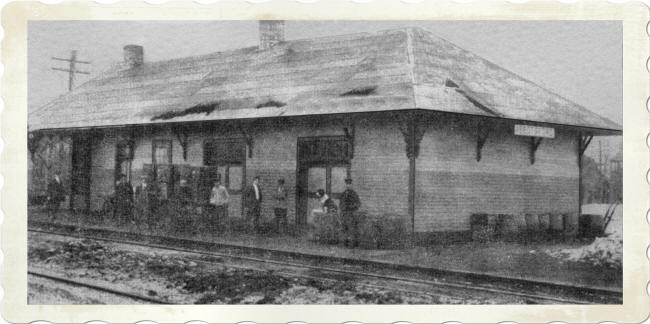
History: Abbotsford Train Depot (2008)
Surnames: Abbot, Holtz
Source: The Tribune Phonograph (Abbotsford, Clark Co., WI), Vol. 48, No. 7, Wednesday, February 13, 2008, extracted from special supplement of the new city hall and library dedication, page 3.
Abbotsford owes its name, foundation to railroads
Abbotsford owes a great deal to Wisconsin Central Railroad Company. More than 100 years ago, it was responsible for shuttling people from this area to the northern forests. It helped a little clearing become a village. Abbotsford even got its name from Edwin H. Abbot, a president of Wisconsin Central.
The company was formed in 1871 and finished its first track to what is now Abbotsford two years later.
Central charted a line with the name Wisconsin and Minnesota Railroad Company and finished a track between Abbotsford and Chippewa Falls in 1880. That same year a passenger could travel from here to Chicago or make it all the way to Minneapolis.
Days Long Past-The Old depot was built in 1881 and served as many as 12 passenger trains a day.
In 1881, a depot popped up along with the Beanery which served as a 136-seat restaurant and 21-bed hotel. Most of the business came from a line running from Stevens Point to Ashland, which came with the timber boom.
While tracks went North, South and West, Abbotsford Northeastern (ANE) planned to build a line to Merrill but only got as far as Goodrich.
Technology was also changing the ways trains ran. Before 1880, wood was used to fire the engines, but that soon changed to coal. An 80-foot coal chute was constructed to load trains. The site later became Holtzís Feed Mill, now owned by TP Printing Co.
In 1886 iron rails were replaced by steel, and the first tracks had to be remade. The men working with the tracks got a lot less than the men on the trains. Section hands received $1 a day while conductors earned $75 a month and engineers made $90 a month.
At the turn of the century, divisions of Wisconsin Central were enlarged and cities shifted in influence on the tracks. Stevens Point and Waukesha were no longer main division points but Abbotsford, Fond du Lac and St. Paul kept their importance.
The water that powered the engines was stored in a large tank near the roundhouse turntable, which was South of town. In 1903, a pipeline was laid from the Eau Plaine River to Abbotsford along what in now Highway 29. It supplemented two wells in the village that couldnít handle demands.
At the railroads height in Abbotsford, a dozen passenger trains came through every day. Regular freight trains were also frequently on the tracks.
However, with any boom comes a bust, as the area soon discovered. Rumors had been circulating that Wisconsin Central was going to merge or consolidate.
On April 1, 1909, Central was sold for $52 million to St. Paul and Sault Ste. Marie, usually called the Soo Line. Another track was built from Spencer to Owen that took business form Abbotsford. A depression struck as the timber industry dried up and property values plummeted.
Agriculture brought the town back as settlers put down axes and took up plows. The railroad, however would never regain its influence as farmer used trucks instead of train cars to transport their milk.
As highways expanded and cars became dominant, the railroad fell into decline. In 1958 the last passenger train left Abbotsford.
Today, a couple of trains pass through each day, serving Meigs in Abbotsford and Northwest Hardwoods in Dorchester. Though the rumble on the tracks still resonates itís only an echo of yesteryear.
|
© Every submission is protected by the Digital Millennium Copyright Act of 1998.
Show your appreciation of this freely provided information by not copying it to any other site without our permission.
Become a Clark County History Buff
|
A site created and
maintained by the Clark County History Buffs
Webmasters: Leon Konieczny, Tanya Paschke, Janet & Stan Schwarze, James W. Sternitzky,
|